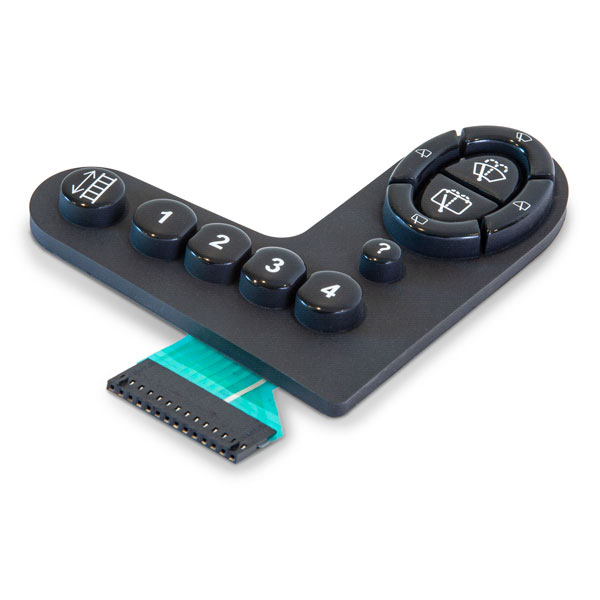Explore the Benefits of Using a Membrane Switch in Modern Devices
Explore the Benefits of Using a Membrane Switch in Modern Devices
Blog Article
Understanding Membrane Changes: The Key to Durable and Trustworthy Controls

What Are Membrane Layer Switches?
Membrane layer switches are an advanced service in the realm of individual interface technology, integrating performance and design effortlessly. These gadgets act as a user interface in between individuals and electronic systems, incorporating numerous components into a portable layout. Normally constructed from flexible, slim layers of products, membrane buttons are developed to reply to touch, enabling users to connect with equipment and electronic devices effectively.
The key elements of a membrane layer button include a printed circuit layer, visuals overlay, and a spacer layer that prevents unintentional activation. The graphic overlay can be personalized to mirror brand name identity or user choices, enhancing aesthetic appeals while making sure use. Membrane layer buttons are typically used in various applications, including clinical tools, consumer electronics, and commercial equipment, owing to their sturdiness and resistance to environmental variables such as wetness and dust.
One of the vital advantages of membrane buttons is their capacity to endure wear and tear, making them ideal for high-traffic environments. In addition, they are light-weight and require marginal space, permitting for innovative designs in item advancement. In general, membrane switches over stand for a efficient and practical option for modern electronic interfaces, marrying modern technology with user-centric design principles.
Just How Membrane Changes Job
The operation of membrane switches over joints on a straightforward yet effective mechanism that converts individual input into electronic signals. When an individual presses the button, the leading layer flaws, permitting a conductive element in the circuit layer to make call with a matching conductive pad on the bottom of the visuals overlay.
The style of membrane switches can differ, but they commonly include domes or tactile aspects to supply comments to the individual, boosting the total experience - membrane switch. The products used in membrane buttons, such as polyester or polycarbonate, add to their sturdiness and resistance to environmental elements, consisting of wetness and dirt. The published circuits are normally encapsulated, which secures them from wear and tear over time.
Advantages of Membrane Buttons

Furthermore, membrane click for more info layer switches are known for their toughness. Constructed from durable materials, they are resistant to dust, moisture, and physical wear, which significantly extends their life expectancy compared to traditional mechanical switches. This resilience makes them specifically ideal for high-traffic atmospheres and applications needing durability.
Another considerable advantage is the convenience of cleansing and maintenance. The smooth surface area of membrane layer switches decreases dirt accumulation and is commonly unsusceptible spills, making them excellent for setups that need regular sanitization.
Additionally, membrane layer buttons offer a advice structured account, bring about a thinner layout that can be incorporated right into different devices without adding mass. This function not only boosts the aesthetic allure but additionally adds to a more ergonomic item design.
Applications of Membrane Switches
User-friendly and versatile, membrane layer buttons find applications across a variety of sectors, consisting of medical gadgets, consumer electronics, and industrial equipment. In the medical field, these switches are integral to tools such as diagnostic devices, individual surveillance systems, and infusion pumps, where reliability and ease of cleaning are vital. Their capability to maintain and endure extreme environments capability makes them optimal for such applications.

In customer electronics, membrane layer buttons are utilized in items like microwaves, washing devices, and push-button controls - membrane switch. Their streamlined design enables user-friendly interface, enhancing the overall individual experience while giving resilience and resistance to damage
Commercial equipment additionally profits from membrane switches, specifically in control panels for machinery and automation systems. These buttons use security against dust and wetness, ensuring consistent efficiency in tough settings. In addition, their personalized functions enable makers to customize them to details functional demands, improving efficiency and functionality.
Choosing the Right Membrane Layer Switch
When choosing a membrane layer button, it is vital to consider different elements that affect efficiency and viability for certain applications. The primary factors to consider include ecological conditions, tactile comments, durability, and style specifications.
First, assess the operating environment; buttons subjected to dampness, chemicals, or extreme temperature levels require certain materials to make sure durability and capability. Next off, examine the requirement for responsive responses. Relying on user interaction, some applications might benefit from a tactile action to confirm activation, while others might favor a non-tactile design for aesthetic reasons.
Longevity is an additional important variable; membrane switches ought to be designed to endure regular usage, influences, and abrasion. Guarantee the picked button can withstand the expected lifecycle, especially in high-usage circumstances.

Conclusion
To conclude, membrane layer changes act as important More hints components in the design of reliable and long lasting control systems across various industries. Their portable layout, incorporated with durable building and personalized features, enhances individual communication while guaranteeing durability in demanding environments. The convenience of membrane layer changes enables tailored remedies that fulfill specific functional requirements, enhancing their importance in modern innovation. As markets remain to evolve, the significance of incorporating reliable membrane switch remedies can not be overstated.
Membrane layer changes represent an essential element of modern interface layout, mixing performance with resilience in various applications.Membrane buttons are a sophisticated solution in the realm of customer interface modern technology, combining capability and style flawlessly. Generally created from adaptable, thin layers of products, membrane switches are developed to react to touch, allowing users to interact with machinery and digital devices efficiently.
The style of membrane buttons can differ, however they commonly integrate domes or tactile aspects to offer feedback to the individual, improving the total experience.In final thought, membrane switches offer as vital components in the design of sturdy and reputable control systems throughout various markets.
Report this page